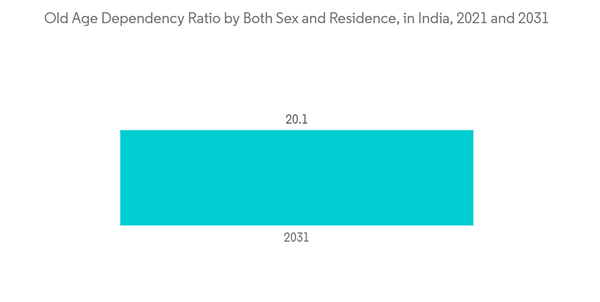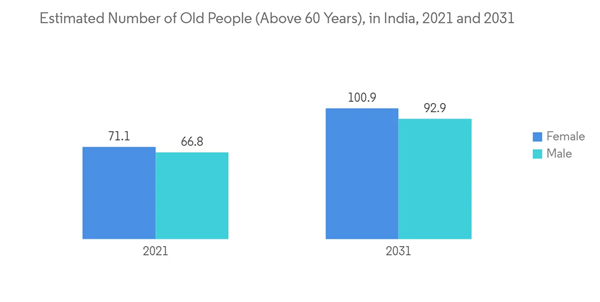COVID-19 had a significant impact on the neurology devices market in India. In January 2022, a research study published in the Lancet stated that in India, several neuroimaging abnormalities have been noted in patients with COVID-19-associated mucormycosis, such as basal meningeal enhancement, entrapment of cranial nerves, watershed infarcts, areas of cerebritis, and cerebral abscesses, which showed lack of preparedness in neurological fields. Hence due to the abovementioned factors, COVID-19 had a notable impact on India’s neurology devices market.
Furthermore, initiatives such as hospital launches for neurological disorders post-COVID are one of the key factors in market growth. For instance, in April 2022, Goutam Hospitals launched a neuro and multi-specialty hospital in Hyderabad. The hospital's large, eight-floor structure is furnished to meet the multispecialty demands of patients. It features 60 beds, 2 operating rooms, 4 intensive care units with 30 beds each, 10 recovery beds, 15 emergency beds, and 6 outpatient consultation rooms for patients to meet with specialists. The hospital offers multi-specialty care in neurology and neurosurgery and features cutting-edge diagnostic tools such as a neuro lab, biochemistry lab, CT scan, X-ray, and ultrasound. Thus, such initiatives are expected to increase market growth over the forecast period.
The key factors propelling the growth of the market in India are the increasing incidence of neurological disorders, huge investments by private players in neurology devices, an increase in R&D in the field of neurotherapy, and the rising aging population. The growth of the neurology devices market in India is also attributed to the increasing incidence of neurological disorders that include brain aneurysms, brain tumors, epilepsy, memory disorders, multiple sclerosis, Parkinson’s disease, peripheral neuropathy, post-herpetic neuralgia, spinal cord tumor, and stroke.
A study published in August 2021 in the National Library of Medicine, reported that in the past three decades, most studies in India have shown a high disease burden for specific diseases including stroke, epilepsy, headache, Parkinson's disease, and dementia, which are mostly reported for the urban Indian population. Similarly, various studies provide insight into the advantages of neuro therapies such as neurostimulation. For instance, the article published in the Current Psychiatric Reports in December 2021 concluded that in fear-related diseases such as PTSD and anxiety, neurostimulation is a promising therapy that avoids the discomfort of conscious exposure associated with traditional therapies. Thus, such studies are expected to boost market growth during the forecast period.
Moreover, increasing healthcare spending, increasing investment by medical device manufacturers, and increasing neurological disease prevalence are expected to drive the overall neurology devices market growth in India. For instance, in June 2022, the Indian Council of Medical Research (ICMR) and the Department of Health Research (DHR) unveiled the ICMR-DHR-Centre of Excellence (CoE) for fostering 'MedTech.’ The ICMR-DHR-Centre of Excellence was launched at IIT-Bombay, IIT-Delhi, IIT-Guwahati, IIT-Hyderabad, IIT-Kanpur, IIT-Kharagpur, and IIT-Madras. These centers have been set to develop the products and technologies in synergy with the requirements of the National Health Mission, Ayushman Bharat, and the Public Health Program of the government. Through this initiative, medical device production is anticipated to increase and thereby boost the market growth in India. Due to the abovementioned factors, the Indian neurology devices market is anticipated to grow over the forecast period.
However, the high cost of neurology devices restrains the market growth.
India Neurology Devices Market Trends
The Neurostimulation Devices Segment is Expected to Hold a Significant Market Share Over the Forecast Period
Neurostimulation devices are implantable, programmable medical devices that deliver electrical stimulation to a specific part of the patient’s brain, spinal cord, or peripheral nervous system to help treat various conditions, including chronic pain, movement disorders, epilepsy, and Parkinson’s disease. Neuromodulation is an intracranial, electrical neuromodulation therapy that has US Food and Drug Administration (USFDA) approval for the treatment of neurological diseases such as bladder control, headache, tremors, chronic pain, stroke, minimally conscious state, and spinal cord injury, which are primarily found in the elderly population. The increased geriatric population in India is a major factor driving market growth. For instance, according to the “Elderly India 2021” report, the population's age-wise distribution exhibits an increasing trend in the proportion of the people belonging to the age group 60 years and above from 7.4% in the past year to a projection of 13.2% by 2031.Factors such as product launches, mergers and acquisitions, research and development, and key market players boost the growth of the Indian neurostimulation devices segment. For instance, in February 2022, India Medtronic Private Limited, a wholly-owned subsidiary of Medtronic PLC, conducted the first clinical procedure in India with the Intellis Spinal Cord Stimulation (SCS) platform, the world’s smallest Spinal Cord Stimulator (SCS) device for the management of certain types of chronic intractable pain. Jaslok Hospital and Research Centre, Mumbai, successfully implanted the first Intellis device in a patient in India for managing pain.
Thus, according to the abovementioned factors, the neurostimulation devices segment is anticipated to grow over the forecast period.
Neurosurgery Devices Segment is Expected to Hold a High Growth Over the Forecast Period
Factors such as the increasing aging population in the country and product launches are key factors in segmental growth. The growing geriatric population is prone to neurological disorders, which is expected to increase the demand for neurosurgery, thus, increasing market growth during the forecast period. For instance, as per the “Elderly India 2021” report in 2021, the total aging population above 60 years in India was around 137.9 million, with 66.8 million males and 71.1 million females, which is expected to increase to 193.8 million in 2031 with 92.9 million males and 100.9 million females. Thus, with such a high geriatric population, the adoption of neurology devices for surgical treatment is expected to grow in the country.Product launches are key factors in market growth as they provide innovative and advanced efficient solutions, increasing the success rate of treatments. Hence, the adoption of such products increases, increasing market growth over the forecast period. For instance, in June 2022, Medtronic PLC launched a fourth-generation flow diverter, Pipeline Vantage with Shield Technology, for the endovascular treatment of brain aneurysms. Pipeline Vantage with Shield Technology is a new flow diverter with enhanced design features for the delivery system and implant. These features allow physicians to deliver, deploy, and treat brain aneurysms and intracranial aneurysms with greater ease and reliability while providing a scaffold that promotes the growth of cells in the inner lining of the target blood vessel. Similarly, launches of brain mapping devices are another key factor as these are important to provide an accurate map of the brain required for brain surgery. For instance, in August 2022, IBS Hospital in India launched a brain mapping device. The device provides personalized brain mapping for the treatment of brain tumors. Brain surgeries become safer due to the accuracy as damage to important brain areas can be avoided.
Thus, increasing population and product launches are expected to increase the adoption of neurosurgery, which is expected to increase segmental growth over the forecast period.
India Neurology Devices Market Competitor Analysis
The Indian neurology devices market is moderately fragmented and competitive in nature due to the presence of several companies operating globally and regionally. The competitive landscape includes an analysis of a few international and local companies that hold market shares and are well known. Major players include B. Braun Melsungen AG, Boston Scientific Corporation, Stryker Corporation, Medtronic PLC, and Nihon Kohden Corporation, among others.Additional benefits of purchasing the report:
- The market estimate (ME) sheet in Excel format
- 3 months of analyst support
This product will be delivered within 2 business days.
Table of Contents
Companies Mentioned (Partial List)
A selection of companies mentioned in this report includes, but is not limited to:
- B. Braun Melsungen AG
- Boston Scientific Corporation
- Johnson and Johnson
- Medtronic PLC
- MicroPort Scientific Corporation
- Nihon Kohden Corporation
- Smith & Nephew
- Stryker Corporation
Methodology

LOADING...










